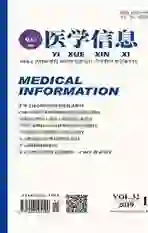CD44v4在乳腺浸润性导管癌中的表达及其与浸润转移的关系
2019-07-03李俊李春英
李俊 李春英


摘要:目的 探讨CD44v4在浸润性乳腺导管癌中的表达及其与浸润转移的关系。方法 选取2011年1月~2018年3月我院收治的乳腺浸润性导管癌185例设为观察组,另选取同期收治的乳腺良性疾病患者60例设为对照组,采用免疫组化法检测两组CD44v4的表达情况,并比较观察组CD44v4表达及临床病理因素情况。结果 观察组CD44v4阳性表达率为60.54%,高于对照组的5.00%,差异有统计学意义(P<0.05)。CD44v4表达在不同年龄、绝经前后月经状况、原发瘤大小间比较,差异无统计学意义(P>0.05);不同TNM分期、组织学分级、淋巴结转移患者的CD44v4表达比较,差异有统计学意义(P<0.05)。结论 CD44v4蛋白在乳腺浸润性导管癌患者中为高表达,检测其表达可作为判断肿瘤预后的新指标。
关键词:浸润性乳腺癌;CD44v4;浸润转移
中图分类号:R737.9 文献标识码:A DOI:10.3969/j.issn.1006-1959.2019.11.025
文章编号:1006-1959(2019)11-0095-03
Abstract:Objective To investigate the expression of CD44v4 in breast invasive ductal carcinoma and its relationship with invasion and metastasis.Methods A total of 185 patients breast invasive ductal carcinoma as observation group, and 60 patients with benign breast diseasea as control group, were admitted to our hospital from January 2011 to March 2018. The immunohistochemical method was used to detect the expression of CD44v4 between two groups, and the correlation between the CD44v4 expression and clinicopathologic factors of observation group was analyzed.Results The positive rate of CD44v4 expression was 60.54%,which was higher than that 5.00% of control group, the difference was statistically significant (P<0.05). There was no statistically significant among different age, pre- and postmenopausal, different size of primary tumors with CD44v4 expression in observation group(P>0.05); there was statistically significant between CD44v4 expression and patients in different TNM stage, histological grade and lymph node metastasis(P<0.05).Conclusion CD44v4 is highly expressed in breast invasive ductal carcinoma patients, and it can be used as a new marker to judge the prognosis of breast cancer.
Key words:Breast invasive ductal carcinoma;CD44v4;Invasion and metastasis
乳腺癌(breast cancer)是我国女性常见恶性肿瘤,上世纪90年代以来,中国乳腺癌发病率的增长速度是全球的2倍[1]。乳腺癌死亡的主要原因是肿瘤转移[2]。CD44v4是细胞黏附分子CD44家族中的一种变异体,目前发现在胃癌,膀胱癌等肿瘤中有表达,且与肿瘤的浸润、转移存在相关性[3-5],但其在乳腺癌中的研究则较少报道。本研究主要探讨CD44v4在浸润性乳腺癌组织中的表达及其与浸润转移的关系,现报道如下。
1资料与方法
1.1一般资料 选取2011年1月~2018年3月柳州市柳铁中心医院收治的经病理确诊的乳腺浸潤性导管癌患者185例设为观察组,均为女性,年龄29~73岁,中位年龄53岁。另选取同期乳腺良性疾病患者60例设为对照组,均为女性,年龄21~68岁,中位年龄43岁。两组年龄比较,差异无统计学意义(P>0.05),可比较。本研究经医院伦理委员会审批通过。
1.2方法 两组均采用免疫组化法[6]检测CD44v4的表达情况。石蜡切片常规脱蜡水化后,用磷酸盐缓冲液(phosphate buffered solution,PBS)冲洗,3次×3 min,然后进行组织修复。每张切片加1滴或50 μl的3%H2O2,室温下孵育10 min,以阻断内源性过氧化物酶的活性,PBS冲洗,3次×3 min。除去PBS液,每张切片加1滴或50 μl的一抗(CD44v4),4℃过夜,PBS冲洗,3次×5 min。除去PBS液,每张切片加1滴或50 μl放大剂(试剂A),室温下孵育10 min,PBS冲洗,3次×3 min。除去PBS液,每张切片加1滴或50 μl多聚酶结合物(试剂B),室温下孵育10 min,PBS冲洗,3次×3 min。除去PBS液,每张切片加1滴或50 μl新鲜配制的DAB溶液,显微镜下观察3~5 min。自来水冲洗,苏木素复染,用0.1% HCl分化,自来水冲洗,PBS返蓝。DAB显色,切片经梯度酒精脱水干燥(二甲苯透明),中性树胶封固。用PBS代替一抗作为阴性对照,用正常乳腺导管上皮组织做阳性对照。CD44v4单克隆抗体购自福州迈新生物技术有限公司。
1.3结果判断 CD44v4以包膜着色为主,可有少量胞浆着色,结果判定根据阳性细胞的数量和染色深度综合判断,阳性结果呈棕黄色颗粒[7]。从每例标本的石蜡切片中随机取5张切片进行免疫组织化学染色。每个标本在显微镜下随机选取不重叠的10个高倍视野的阳性细胞进行计数,每张切片由2人观测。按阳性细胞占总细胞数的百分比评分:0分为阴性,阳性细胞数≤5%;1分为阳性,细胞数5%~25%;2分为阳性,细胞数25%~75%;3分为阳性,细胞>75%。按着色强度评分:0分为无着色,1分为浅黄色,2分为黄色,3分为棕黄色,取两项评分的乘积作为总积分,≤1分为阴性,>1分为阳性。
1.4观察指标 比较两组CD44v4表达率,以及观察组乳腺浸润性导管癌患者CD44v4表达与临床病理。
1.5统计学方法 采用SPSS 16.0统计学软件进行数据分析。计量资料以(x±s)表示,采用t检验;计数资料以[n(%)]表示,采用?字2检验。以P<0.05表示差异有统计学意义。
2结果
2.1两组CD44v4表达率比较 观察组CD44v4阳性表达率为60.54%(112/185),高于对照组的5.00%(3/60),差异有统计学意义(?字2=43.05,P<0.05),见图1。
2.2观察组CD44v4表达与临床病理参数比较 观察组185例乳腺浸润性导管癌患者中,CD44v4阳性表达112例(60.54%),阴性表达73例(39.46%)。CD44v4表达在不同年龄、绝经前后月经状况、原发瘤大小间比较,差异无统计学意义(P>0.05);不同TNM分期、组织学分级、淋巴结转移患者的CD44v4表达,差异有统计学意义(P<0.05),见表1。
3讨论
CD44v4是细胞粘附因子CD44变异体的一员,参与细胞-细胞、细胞-胞外基质之间的特异性黏附,在食管癌、胃癌、肝癌、头颈部肿瘤等肿瘤细胞中均有阳性表达,是参与肿瘤生长,分化和血道淋巴道转移的重要因子[5,8-10],其在乳腺癌的复发转移中也发挥着重要作用[11]。有研究证实,肿瘤浸润转移过程中的一个关键步驟就是脱落的肿瘤细胞穿过血管内皮进而迁移,在这个过程中,内皮细胞E-选择素起着举足轻重的作用[12],CD44v4则是介导乳腺癌细胞跨内皮转移的一个主要的E-选择素配体[13]。乳腺癌脱落细胞上的选择素配体CD44v4与血管内皮细胞上表达的E选择素结合,介导粘附过程[11]。但CD44v4的阳性表达与乳腺癌肿瘤的大小、分级及淋巴结转移等临床病理参数的相关性目前尚不明确。
本研究结果显示,观察组CD44v4阳性表达率为60.54%(112/185),高于对照组的5.00%(3/60),差异有统计学意义(P<0.05),说明乳腺癌组织中CD44v4浓度高于临近的非癌组织,在乳腺癌组织中有阳性高表达。CD44v4表达在不同年龄、绝经前后月经状况、原发瘤大小比较,差异无统计学意义(P>0.05);CD44v4表达在不同TNM分期、不同组织学分级、淋巴结转移患者中比较,差异有统计学意义(P<0.05),说明TNM分期、病理组织学分级、淋巴结转移参与乳腺癌的恶性进展,增强了乳腺癌肿瘤细胞的侵袭性。因此,通过研究CD44v4在乳腺癌发生发展中的作用,对判断肿瘤的生物学特性和预后均具有重要意义。
综上所述,CD44v4蛋白在乳腺浸润性导管癌患者中为高表达,检测其表达可作为判断肿瘤预后的新指标。
参考文献:
[1]Fan L,Strasser-Weippl K,Li JJ,et al.Breast cancer in China[J].Lancet Oncol,2014,15(7):279-289.
[2]Chas M,Boivin L,Arbion F,et al.Clinicopathologic predictors of lymph node metastasis in breast cancer patients according to molecular subtype[J].J Gynecol Obstet Hum Reprod,2018,47(1):9-15.
[3]Wang HK,Liang JF,Zheng HX,et al.Expression and prognostic significance of ECT2 in invasive breast cancer[J].J Clin Pathol,2018,71(5):442-445.
[4] Zeilstra J,Joosten SP,van Andel H,et al.Stem cell CD44v isoforms promote intestinal cancer formation in Apc(min) mice downstream of Wnt signaling[J].Oncogene,2014,33(5):665-670.
[5]李键淇,齐洁敏.整合素α2β1及CD44v4在胃癌组织中的表达及意义[J].中国老年学杂志,2017,37(4):910-912.
[6]中国抗癌协会乳腺癌专业委员会.《中国抗癌协会乳腺癌诊治指南与规范(2017年版)》修订小组成员[J].中国癌症杂志,2017,27(9):695-760.
[7]Ma Y,Zhang S,Zang L,et al.Combination of shear wave elastography and Ki67 index as a novel predictive modality for the pathological response to neoadjuvant chemotherapy in patients with invasive breast cancer[J].Eur J Cancer,2016(69):86-101.
[8]Kashyap T,Pramanik KK,Nath N,et al.Crosstalk between Raf-MEK-ERK and PI3K-Akt-GSK3β signaling networks promotes chemoresistance, invasion/migration and stemness via expression of CD44 variants (v4 and v6) in oral cancer[J].Oral Oncol,2018(86):234-243.
[9]Spiegelberg D,Kuku G,Selvaraju R,et al.Characterization of CD44 variant expression in head and neck squamous cell carcinomas[J].Tumour Biol,2014,35(3):2053-2062.
[10]Athanassiou-Papaefthymiou M,Shkeir O,Kim D,et al.Evaluation of CD44 variant expression in oral, head and neck squamous cell carcinomas using a triple approach and its clinical significance[J].Int J Immunopathol Pharmacol,2014,27(3):337-349.
[11]Geng Y,Chandrasekaran S,Hsu JW,et al.Phenotypic switch in blood: effects of pro-inflammatory cytokines on breast cancer cell aggregation and adhesion[J].PLoS One,2013,8(1):54959.
[12]Kozlowski J,Kozlowska A,Kocki J.Breast cancer metastasis-insight into selected molecular mechanisms of the phenomenon[J].Postepy Hig Med Dosw,2015(69):447-451.
[13]Zen K,Liu DQ,Guo YL,et al.CD44v4 is a major E-selectin ligand that mediates breast cancer cell transendothelial migration[J].PLoS One,2008,3(3):e1826.
收稿日期:2019-3-12;修回日期:2019-3-22
編辑/杜帆
